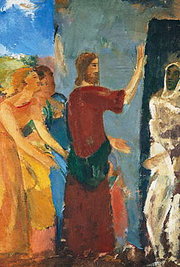Lazarus
|
|
- This article is the Biblical character Lazarus. For the Lazarus computer software project, see Lazarus (software).
Juan_de_Flandes_001.jpg
Lazarus is a proper name referring to a character of the Bible. The name has also appeared in modern day literature and science fiction.
| Contents |
Bible
In the New Testament, Lazarus (אֶלְעָזָר "God has helped", Standard Hebrew Elʿazar, Tiberian Hebrew ʾElʿāzār) is the name of a figure in one of Jesus' parables, recorded in the Gospel of Luke 16:19-31. "Lazarus is the beggar at the rich man's table, who receives his reward in the Hereafter, in Abraham's bosom at the everlasting banquet, while the rich man craves a drop of water from Lazarus' finger."
Lazarus is also a man mentioned several times in the four Gospels, who lived in the town of Bethany with his sisters Mary and Martha. He is best known for being raised from the grave four days after his death by Jesus, according to the Gospel of John ch. 11. Again according to this gospel, many Jews visited Lazarus after this and believed in Jesus in part because of Lazarus' resurrection. The Gospels say no more of Lazarus.
In Hebrew, the god Osiris (whose name in demotic/haeroglyphics is thought to have been pronounced Aser) is also translated Elaser (from "El" meaning god and "Aser"). There are several similarities with the story of Osiris being raised from the dead, such as the location. In the Bible the raising is placed in "Bethany" (which in Hebrew can also be "Beth-Anu", "Beth" meaning "house"), wheras in the Osiris legend, it is placed in the house of the dead (which in demotic is a place named "Annu"). This similarity is used by some scholars to suggest that the Lazarus story is part of a general body of works shared between Mystery religions in the Mediterranean, which became absorbed into the Jesus story. Note that an alternative rendering of El and Aser is Aserel, i.e. Azrael, the angel of death.
According to Christian mythology recorded in the 13th century Golden Legend, Lazarus was the brother of Martha and Mary Magdalene, a Pharisee, but because of the rumoured plots fled for his life to Cyprus, where he later became a Christian bishop and lived another thirty years. Stories say that he would always include something sweet in every meal, but that he was only known to laugh once in that time. That was when he observed someone stealing a clay pot, causing him to smile and say with a laugh, "clay stealing clay". Medieval tradition also sent Mary, Martha, and Lazarus to France after the Crucifixion, and pilgrims visited their tombs at the abbey of Vézelay in Burgundy. The cathedral of Autun, not far away, is dedicated to Lazarus (Saint Lazaire).
Lazarus is also the name of the beggar before the door of Dives in the parable of Lazarus and Dives in the Book of Luke.
Modern Age
Today Lazarus is honored as a saint by Christians who honor saints. The transfer of his relics from Cyprus to Constantinople in 898 is remembered each year on October 17. In the Eastern Orthodox Church, the Saturday before Palm Sunday is remembered as "Lazarus Saturday", and the scripture readings and hymns focus on Lazarus as a promise of the resurrection of all. In Christian funerals, the idea of the deceased being raised by the Lord as Lazarus was raised is expressed in prayer. He is best known for being raised from the grave by Jesus four days after his death.
In the motion picture The Last Temptation of Christ, Jesus raises Lazarus from the dead but Lazarus is subsequently murdered by Jewish zealots who seek to discredit Jesus of Nazareth as the Messiah.
In Entertainment
Other mentions of Lazarus include the Star Trek episode "Requiem for Methuselah", which fictionalized Lazarus as an immortal man known as "Flint", born in the year 3834 BC, and gifted with immortality through instant tissue regeneration. A second Star Trek character named Lazarus, unrelated to the historic Lazarus, was portrayed in "The Alternative Factor" as an insane scientist bent on destroying the universe. Besides this, Robert A. Heinlein has a series of novels that feature someone named Lazarus Long, who possesses an unaturally long life span. An episode of the War of the Worlds TV series titled "The Raising of Lazarus" revolves around an alien found in a state of suspended animation that wakes to wreck havoc. A first season Stargate SG-1 episode is titled "Cold Lazarus".
Variations on the Lazarus themes also appear in other media, such as the Batman series of comic books. The criminal mastermind Ra's al Ghul (Arabic for "The Demon's Head") relies on his "Lazarus Pits" to maintain his youth, as well as to heal him when injured. According to Batman canon, Ra's Al Ghul has been using these pits for centuries, since his birth in the middle ages. The comic series X-Men also includes a reference to Lazarus. The evil mutant Apocalypse uses his "Lazarus Chamber" to rejuvenate, similar to the Batman villain.
Also notable is an episode of the Nickelodeon television series "The Adventures of Pete and Pete." The episode "Field of Pete" revolves around a mysterious frosty drink known as the "Orange Lazarus," which causes a brain freeze so intense it almost kills whomever drinks it. This episode also makes numerous other biblical references.
The Lazarus Child is a book by Robert Mawson, subsequently released as an independent film in 2004, which tells the tale of a young girl rescued from a comatose state by a doctor depicted as caring and wise, yet maligned and mistrusted because of her unorthodox methods. Of note is a scene in the story where the doctor brings one of her doubters around by similarly reviving another child.
Lazarus is also the name of a single released by Liverpool band the Boo Radleys.
Lazarus is also the name of a single released by progressive rock band Porcupine Tree in 2005.

